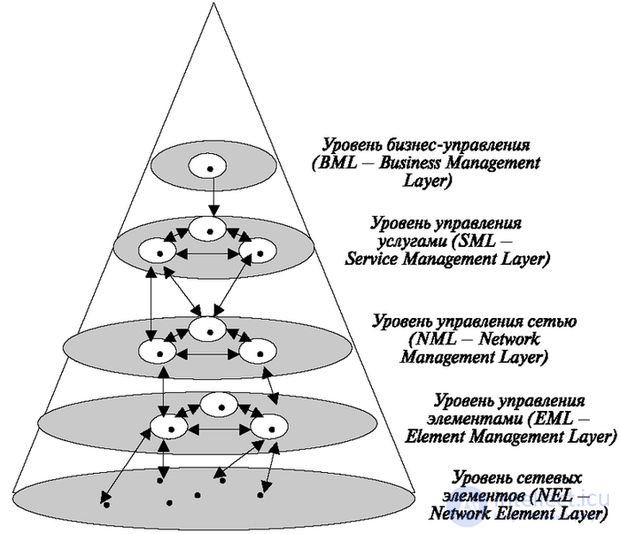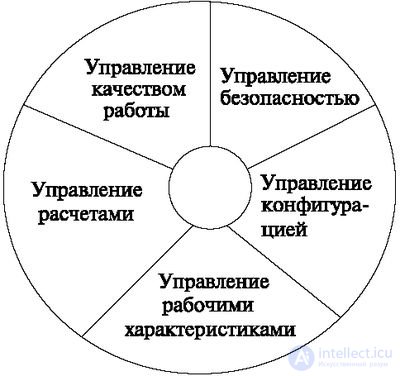Lecture
This Pyramid - Logical Layered Architecture (LLA) classifies tasks according to the complexity of managed elements (from individual devices on a network to intercorporate networks). The pyramid of levels of the TMN control system is shown in Fig. 7.4.

The figure conventionally shows the components of each level and their possible relationships. Consider them, starting with the lower level.
The network element layer (NEL - Network Element Layer) plays the role of an interface between, as a rule, a database with management information base (MIB - Management Information Base) located on a separate device and the TMN infrastructure. This database refers to such network elements as, for example, switching stations, transmission systems, multiplexers, sets of test equipment. It includes Q-adapters and the actual network elements that coordinate the work of the communication network and TMN.
The Element Management Layer (EML) corresponds to the Functional Support Systems (OSS) that control the operation of groups of network elements. This level allows you to manage groups of network elements. At this level, control functions are implemented that are specific to the equipment of a particular manufacturer, and this specificity is masked from the levels above. Examples of such functions are hardware error detection, power consumption and operating temperature monitoring, statistical data collection, measurement of the utilization of computing resources, and updating of firmware. This level includes intermediary devices (although physically they may belong to higher levels) interacting with the OSS via the q 3 interface.
Network Management Layer (NML - Network Management Layer) forms the representation of the network as a whole, based on data about individual network elements that are transmitted by the support systems of the previous level operations through the q3 interface and are not tied to the features of products of a particular company. In other words, at this level, monitoring of the interaction of network elements is carried out, in particular, data transmission routes are formed between the terminal equipment to achieve the required quality of service (QoS), changes are made to the routing tables, the throughput of individual channels, routes and routes is monitored, network performance is optimized and identified failures in her work.
The Service Management Layer (SML) covers the aspects of network operation that users (subscribers or other service providers) directly face. In accordance with the general principles of LLA, information from the NML level is used at this level, but direct control of routers, switches, connections, etc. is no longer possible here. Here are some functions related to service management: quality control of service (QoS) and fulfillment of terms of service contracts (SLA - Service Level Agreement), management of registration records and service subscribers, adding or deleting users, assigning addresses, billing, interacting with other management systems providers and organizations (via xinterface).
The Business Management Layer (BML) considers the communications network from the point of view of the general business objectives of the operating company. It relates to strategic and tactical management, and not operational, like other levels of LLA. Here we are talking about network design and planning of its development, taking into account business objectives, budgeting, organization of external contacts, etc.
Thus, LLA levels define the functional hierarchy of network management procedures without physical segmentation of administrative software. The reason for the emergence of this hierarchy is the need for a logical separation of the functions of controlling individual network elements from the functions belonging to their groups and network connections. It is clear that the approximation of administrative procedures to those resources, which are directed to their impact, increases management efficiency. In addition, the LLA hierarchy allows the use of open standard interfaces for organizing interaction between different levels.
Works on each of the levels in fig. 7.4 five functional areas are allocated (fig. 7.5):
They define a common set of protocols and services that enable the exchange of control information when interacting between a control process and a managed resource using a common set of messages. It is defined in ITU-T recommendations:
M3200 "TMN Management Services", which, in particular, introduce the concepts of "Telecommunications Management" and "Management Area".
Specific services are defined in detail in the following M.32xx series documents:
Consider in more detail these services (Fig. 7.5).

Quality management is designed to control and maintain the required level of the main characteristics of the network. It includes the collection, processing, recording, storage and display of statistical data on the network and its elements; identifying trends in their behavior and warning about possible violations in the work.
Troubleshooting management provides detection capabilities, the location of network faults, their registration; communicating relevant information to the attendants; issuing troubleshooting tips.
Configuration management provides inventory of network elements (their types, location, identifiers, etc.); the inclusion of elements in the work, their configuration and decommissioning; establishing and modifying physical connections between elements.
Settlement management monitors the utilization of network resources and supports the functions of charging for this use.
Security management is necessary to protect the network from unauthorized access. It may include restricting access by means of passwords, issuing alarms when attempting unauthorized access, disabling unwanted users, or even cryptographic protection of information.
In conclusion, we can say that the development of recommendations has not yet been completed. But their importance is undoubted, because they contain descriptions of efficient and systematic ways of processing the various network elements and define the specified functionality, covering the maintenance of operation and maintenance systems, and also determine the distribution of functions, providing the most cost-effective centralized maintenance.
Comments
To leave a comment
Telecommunication Services and Devices
Terms: Telecommunication Services and Devices